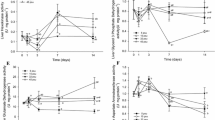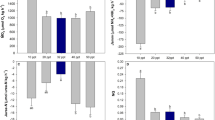Abstract
The aim of this study is to elucidate the osmoregulatory capabilities of the intertidal pulmonate Onchidium tumidium. Our results indicate that O. tumidium could tolerate hyperosmotic stress more effectively than hypoosmotic stress. In 10% seawater (SW), it was capable of maintaining its plasma hyperosmotic and hyperionic to the external medium. However, it rapidly gained weight in 10% SW, and no restoration of body weight was observed. In contrast, in 90% SW it was able to recover its body weight partially. In a hyperosmotic medium, accumulation of intracellular free amino acids (FAA) was responsible for cell volume regulation. The accumulated FAA might originate from protein catabolism, which occurred in the internal organs (IO). In contrast, the relatively smaller amination:deamination ratio of glutamate dehydrogenase in the body wall (BW) and IO of specimens exposed to hypoosmotic stress might lead to a higher rate of amino acid catabolism. This was supported by the greater ammonia contents in the BW and IO of, and higher rate of ammonia excretion by, specimens exposed to 10% SW.
Similar content being viewed by others
Author information
Authors and Affiliations
Additional information
Received: 11 March 1998 / Accepted: 2 May 1999
Rights and permissions
About this article
Cite this article
Chew, S., Ho, S. & Ip, Y. Free amino acids and osmoregulation in the intertidal pulmonate Onchidium tumidium. Marine Biology 134, 735–741 (1999). https://doi.org/10.1007/s002270050590
Issue Date:
DOI: https://doi.org/10.1007/s002270050590




